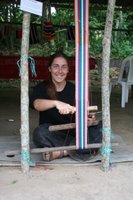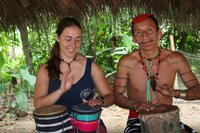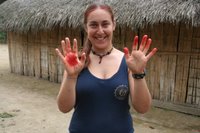Tsachilas (Santo Domingo) by Maya Mahanaymi
 Day 1- I get to
Day 1- I get to
After I have put my things down, I go to get I look around. The hut where I stay is very nice, made of bamboo and palm tree leafs. There is a small hut next to it where they sell traditional art work. A young woman come to me and offers me a bowl with some kind of food. I look at it and am overwhelmed to see huge fat worms squirming around. They eat them while they’re still alive! Just like Timon and Pumba eat them from the tree in the ‘lion king’. My guts do a 360 degrease twist, but I smile and turn it down politely. Later, dinner is served, and I’m eating with good appetite the rice and berde (green banana) I am so used to by now. I must say I feel a bit lonely now that I’m not living with a family…
Day 2- In the morning I go with Manuel to a trip in the plantations and wild forest near by.  He shows me the medical plants and trees, and explains the use of each of them. Later, in the afternoon I learn how to weave like their traditional weaving. It’s very relaxing, but after a while it’s also back braking…
He shows me the medical plants and trees, and explains the use of each of them. Later, in the afternoon I learn how to weave like their traditional weaving. It’s very relaxing, but after a while it’s also back braking…
After dinner I go through a medical ceremony. I go to the hut where it is held. The hut is full of light smoke and smell of incense. There is a table there with some stones and bowl with water and medicals plants. I’m asked to sit down, and I do so. Manuel is dressed in the traditional clothes and has painted his body with black stripes. He starts humming a relaxing tone that is repeated during the whole ceremony. Then he holds up two stones and dips them in a bowl with water and medical plants. He knocks the stones into each other, which makes a nice clinking sound. Then he puts the stones on my forehead, and rubs them in circles. After a while I’m asked to lie down, and get the massage in my shoulders and stomach too. During the treatment he also sips out of the water with medical plants, and then sprays it around the room. The ceremony is not so long, and is just a small taster of a real ceremony. I’m not even sure Manuel is a real shaman (medical man), but the ceremony was very relaxing, and I go to bed happy while humming the tone he was humming during the ceremony.
Day 3- In the morning I have another medical treatment. This time it is a treatment with damp. There is a hole in the ground full with medical plants. Manuel is heating up stones in a fireplace next to it. I’m asked to sit on a plank that is set over the hole, with a blanket over my head. When the stones are hot enough, Manuel puts them in hole, and they raise hot steam. This steam is supposed to be very good for the airways, and also for the skin.
At noon I’m making a necklace of red and black seeds, that are to find in the area. And later Manuel teaches me a little bit how to play the cultural instruments, and also how to say a few words in the native language they speak.  Before I leave I also get to colour a little bit of my hair red, by the use of a red fruit, and colour my arm with black stripes by the use of another one.
Before I leave I also get to colour a little bit of my hair red, by the use of a red fruit, and colour my arm with black stripes by the use of another one.
I’m heading back to


<< Home